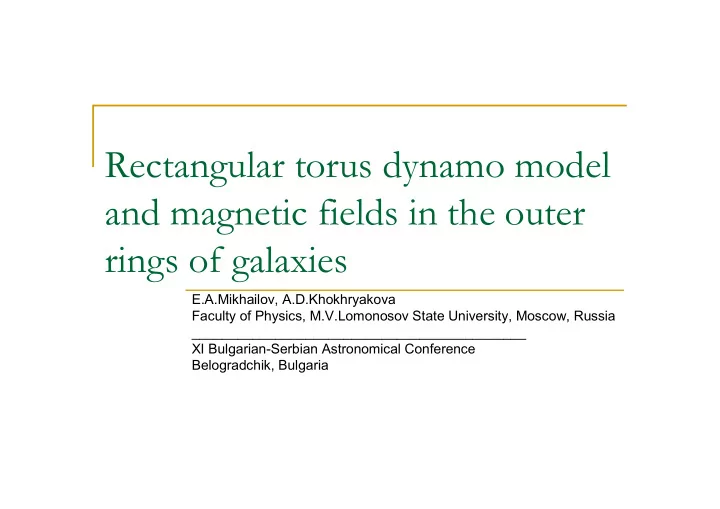

Rectangular torus dynamo model and magnetic fields in the outer rings of galaxies E.A.Mikhailov, A.D.Khokhryakova Faculty of Physics, M.V.Lomonosov State University, Moscow, Russia ____________________________________________ XI Bulgarian-Serbian Astronomical Conference Belogradchik, Bulgaria
Introduction Today it is no doubt that some galaxies have magnetic fields of several microgauss (Beck et al. 1996) Their existence has been proved using both observations and theoretical models. Some of the galaxies have outer rings. It is quite interesting to study the possibility of the magnetic field generation there.
Dynamo mechanism The generation of the magnetic field is described by dynamo mechanism. The dynamo is connected with transformation of energy from turbulent motions to magnetic field. This process is based on joint action of differential rotation and alpha-effect.
Basic equation The large-scale magnetic field evolution is described by Steenbeck – Krause – Rädler equation: Β curl V , B curl B B , t where B is the magnetic field, α characterizes the alpha-effect, η is the turbulent diffusivity coefficient, V is the large-scale velocity of the medium.
Models for the magnetic field Direct solution of the Steenbeck – Krause – Rädler equations is quite complicated. Usually some two-dimensional models for the magnetic field are used. As for galaxies, the equations are usually solved using so-called no- z approximation (Moss 1995). We can use this approximation for the outer ring (Moss et al. 2016).
The outer ring
No- z approximation The galaxy is quite thin, so we can assume that the magnetic field lie in the equatorial plane, so we can omit the equation for its z - component. Some of the derivatives of the magnetic field can be changed by algebraic expressions.
Equations of no- z approximation for outer ring If we measure the field in units of h 2 / η , distances in galaxy radius R , the equations of the magnetic field will be: 2 2 B k B 2 r S B r rB ; r t 4 r r r 2 2 B k B ; 2 S B rB r t 4 r r r where S α characterizes alpha-effect, S ω – differential rotation, λ =a/R – thickness of the galaxy disc, k=a/h, where a is the half-width in the galaxy, h is the half-thickness of the galaxy (Mikhailov 2018).
Nonlinear saturation The magnetic field growth should stop if its induction becomes close to the equipartition value B max . It can be described by nonlinear modification of alpha-effect: 2 2 B B r S S 1 . 2 B max It is quite convenient to measure the field in units of equipartition field.
Nonlinear equations The nonlinear equations are: 2 B B 2 2 2 r S B 1 B B r rB ; r r t 4 r r r 2 B B . 2 S B rB r t 4 r r r Usually the typical values of the parameters are S α =1, S ω =10, λ =0.1 , k=2 . We will solve the equations for values: 1 r 1 . At the boundaries we assume that B=0 .
Magnetic field generation The possibility of the magnetic field generation is described by the dimensionless number: Q=S α S ω . For higher values of Q the magnetic field grows faster, and for lower ones it grows slower or decays.
Magnetic field generation
Problems of the no- z model The no-z approximation was constructed for the main part of the galaxy, where the thickness of the galaxy disc is much smaller than its radial lengthscale. As for the outer ring, we should use the model where we take into account the z- component.
Torus dynamo models Previous works described the magnetic field using round torus dynamo model (Mikhailov 2017). However, it is better to take into account that the ratio between thickness and width of the ring can be different.
Rectangular torus dynamo model It is much more convenient to use the rectangular torus model, which takes into account these details. We will describe the axisymmetric model for the magnetic field which is described as a combination of toroidal magnetic field and vector potential of the poloidal field (Deinzer et al. 1993): . B B e rot A e
Equations for the magnetic field using torus approximation Using the same units, the equations for the magnetic field will be (Mikhailov 2017) A 2 2 S zB 1 B A ; t B A 2 S B . t z
Boundary conditions We will solve the equations for values: 1 r 1 ; z . k k At the boundaries we will use the conditions: A B 0 , 0 . n
Magnetic field in rectangular torus dynamo
Dypolar and quadrupolar fields The magnetic field in the rectangular torus dynamo model grows slower than in the no-z approximation For high Q numbers the magnetic field in the outer ring can have not only the quadrupolar symmetry, it can also have the dypolar symmetry.
Quadrupolar and dypolar magnetic field (poloidal component)
Conclusions We have studied the magnetic field generation using rectangular torus dynamo. The magnetic field grows slower than in the no-z model. This model can describe the field with dypolar symmetry.
References R. Beck, A. Brandenburg, D.Moss et al., Ann. Rev. Astron. Astrophys., 34, 155, 1996. D.Moss, Mon. Not. R. Astr. Soc., 275 , 191, 1995. D. Moss, E. Mikhailov, O. Sil’chenko et al., Astron. Astrophys., 592 , A44, 2016. E.Mikhailov, Astrophysics, 61, 2, 2018. E.Mikhailov, Ast. Rep., 61 , 9, 2017. W. Deinzer, H. Grosser, D. Schmitt, Astron. Astrophys., 273 , 405, 1993.
THANKS FOR ATTENTION!
Recommend
More recommend